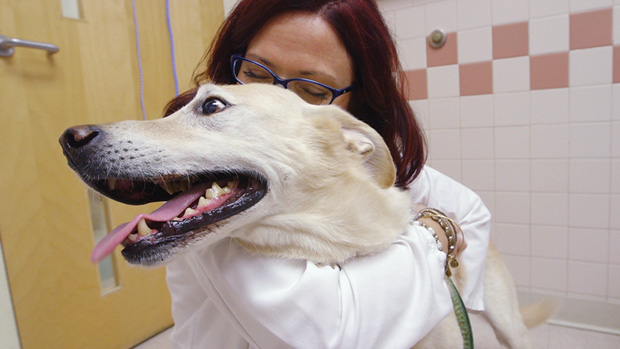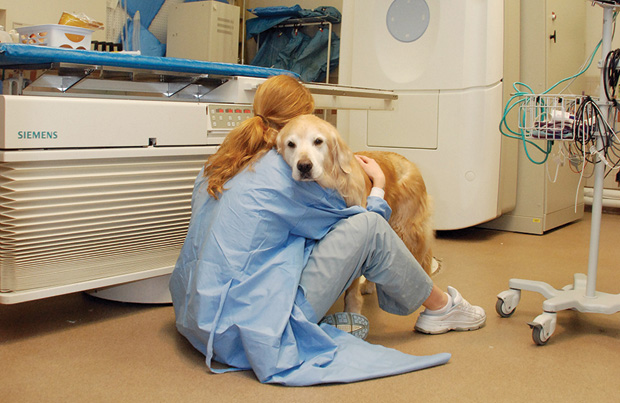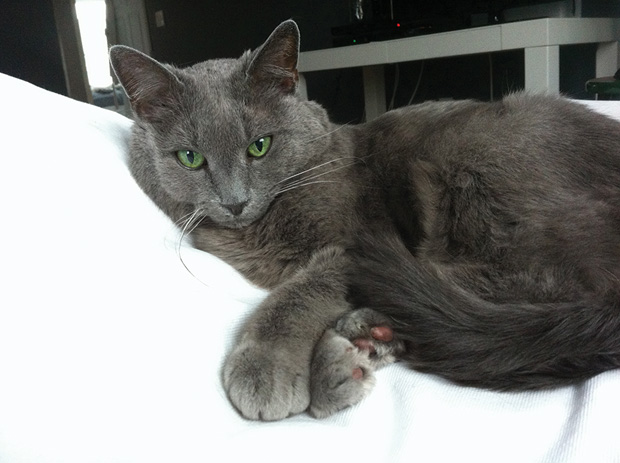About an hour west of Boston, Tufts University’s bucolic North Grafton hospital is full of back surgery patients today. They lie quietly on their sides, lines of stitches along their spines. “Slipped discs,” explains oncologist Kristine Burgess, as she walks through an intensive care unit ward dotted with small, personal touches. “I’m very sweet” reads a handwritten placard on one patient’s door, along with the date of his last MRI.
Overall, it’s a typical medical center, with its linear accelerator and ultrasound machines. There’s a neurology suite, a dermatology department, and a pain specialist. In between are all the modern scourges of man, like a grossly obese patient with type 2 diabetes, another with kidney disease, and a few others with glaucoma, epilepsy, mouth cancer, and lymphoma.
“Selkie!” Burgess greets one of her oncology cases. “This is my favorite girl,” she exclaims, kneeling to scratch her patient behind the ears and massage her sides. “She’s done very well with her lymphoma treatment, so I’ve known her for over three years,” she explains.
Selkie’s disease, like those of her fellow patients, is messy and spontaneous, arising naturally from a mix of her own genetic predisposition and unknown environmental cues. It shows many of the same molecular underpinnings, responds to the same drugs, and develops the same treatment resistance as any human lymphoma. Selkie, though, is not human—she’s a longhaired, chestnut-colored dachshund. In fact, not one of the patients in the entire hospital—that is, the Foster Hospital for Small Animals at the Cummings School of Veterinary Medicine at Tufts University—is human. The glaucoma and oral cancer patients are both cats. The overweight diabetic? A 34-lb pug.
Nine out of ten drugs that enter clinical trials for any given disease these days fail to earn U.S. Food and Drug Administration approval, mostly for a lack of effect. A big part of the problem is because the research behind those drugs is so heavily based on rodent models—mice and rats that have been genetically teased into mockups of our diseases, or transplanted with tumor cells and pumped with immunosuppressants. “Nowadays, it seems like you can give a mouse an aspirin and cure their cancer,” says Burgess (Figure 1). But what about dogs and cats?

Our family pets are models for the very diseases scientists struggle to recapitulate in the lab. A Doberman pinscher that compulsively sucks at his flanks or chases his tail shows the same structural abnormalities in his brain and responds to the same treatments as a human with obsessive–compulsive disorder. A mouse’s BRCA1 “breast cancer” gene shares 56% of its molecular sequence with ours; the dog’s and cat’s, respectively, share 74% and 72% with us. And when our pet dogs are badly injured, they respond at the cellular and molecular levels more similarly to humans than do rodents. In fact, a 2013 article shows that in side-by-side comparisons, the similarities of a mouse’s genetic inflammatory response to a human’s are near random.
“If you want to accelerate the pace at which treatments are developed for humans, if you have a novel approach and a good scientific rationale and you can get it to work in a dog,” says Andrew Hoffman, who directs the nearby Tufts Regenerative Medicine Laboratory, also on the veterinary campus, “then the predictive value of that information model is invaluable.”
Researchers urgently need more information and better, more accurate models for cancer, heart disease, and other complicated diseases—while there are at least 70 million pet dogs and 74 million pet cats in the United States alone that experience these very illnesses all the time. It is an enormous missed opportunity.
Trailblazing with Cancer
This idea of tapping into an animal for human health has been around since at least the mid-1800s, when German researcher Rudolf Virchow advocated for a stronger link between human and veterinary medicine. During the 20th century, dogs were used to develop bone marrow and kidney transplant techniques, as well with the limb-sparing surgeries that became a mainstay for children with bone cancers. In the 1970s and 1980s, University of California, Davis, veterinarian Calvin Schwabe popularized the term “one medicine” to describe the interconnections and parallels of human and animal medicine. But instead of merging, the two medical fields drifted apart over the course of the century.
Only in the last decade or so has this idea of shared health— ”one health” as the term has become—really begun to come into its own. A large part of this renewal stems from environmental and zoonotic concerns, like avian flu and Ebola. Comparative clinical medicine comprises a smaller fraction of this, but even that has gained recent momentum.
First, in 2003, the U.S. National Cancer Institute launched the Comparative Oncology Program (COP), which assembled what are now 20 academic veterinary oncology centers, including Tufts, into the Comparative Oncology Trials Consortium (COTC) to collaborate on research [1]. Then came the dog and the cat genomes, respectively, published in 2005 and—as a rough draft for the cat—2007 (a more comprehensive version appeared last year). In 2013, a biorepository called the Canine Comparative Oncology and Genomics Consortium (CCOGC) also began providing samples from dogs with translatable cancers [2].
Both initiatives have led to a series of publications validating the dog model—identifying shared mutations between human and canine mucosal melanoma, for instance—and exploring novel tumor-targeting compounds in, for instance, dogs with a mix of bone and soft tissue cancers. One of the COTC’s most recent studies was a successful proof-of-concept looking into the potential of dogs as models for personalized cancer treatment, an area where inbred, homozygous rodents are inherently inadequate. Seven more COTC trials are either in progress or in press, and another 11 study protocols have been initiated (Figure 2).

Elsewhere in medicine, similar work is taking place across the country. In his lab at Tufts, Andrew Hoffman is actively exploring stem cell therapies for a heart disorder called mitral valve disease, which leads to congestive heart failure in dogs and humans. At North Carolina State University, veterinary ophthalmologist Brian Gilger is developing more effective drug delivery tools for eye diseases like glaucoma, and several of his ideas are now making their way through the regulatory pipeline to human medicine. Dorothy Cimino Brown at the University of Pennsylvania has developed a canine version of the Brief Pain Inventory, and uncovered an unexpected pain reliever in a receptor path that hadn’t initially translated well from rodents to people. “So should we wait for a new rodent pain model or assay? The answer is no!” reads the editorial accompanying Brown’s report in the journal Anesthesiology. “Dogs have been living with humans as sentinels, assistants, or friends for over 10,000 yr [sic]. Now dogs also show their potential in translational pain research” [3].
Roadblocks
Amy LeBlanc directs the Comparative Oncology Program at the National Cancer Institute (NCI). She’s thrilled at the recent progress, but at the same time, she explains, there’s still a lot of basic work to be done. “When we talk to people, there are some folks who don’t even know that dogs get cancer. The conversation has been started, but it needs to get a lot more traction behind it.”
The consensus in comparative medicine right now is that the area is still underfunded, underpopulated, and underrepresented in most of biomedicine. “If I go to a veterinary meeting, the number of people that are there that are involved in human research, that have an actual grant through the U.S. National Institutes of Health (NIH), is small,” says Hoffman. At human-oriented meetings, it’s even worse, he says. “I went to the International Society for Extracellular Vesicles—there was one other veterinary group. This is one of the biggest, most exciting new areas in the life sciences, and there was one group from Utrecht, and me.”
Part of the problem is the unfamiliarity that LeBlanc cites: people on the human medicine side just aren’t aware of pets’ potential. But the field also needs a blockbuster, a breakthrough, something big and clear that drug companies, doctors, and funders can’t miss.
“For us to win the hearts and minds of our medical colleagues, it absolutely has to go down to the level of data,” says Deborah Kochevar, dean of the Cummings School of Veterinary Medicine at Tufts. “That doesn’t come from rhetoric, it comes from, ‘look, this product came to market two years sooner because of this canine study that was done,’ or the reverse of that—’we washed out a compound much earlier in the pipeline and saved ourselves 4 million dollars.’”
But to get there, comparative medicine needs to develop itself further, and that’s where researchers start running into walls. For instance, some molecular and cellular targets are known in companion animal models, but many are not and so scientists often still need to nail down these details in their diseases. But in the grant review study panels, they’re competing against uberprecise transgenic CRISPR mice with clearly defined modifications and targets. “So if we go to NIH and say we’ve got this novel animal model that’s for all the world just like Crohn’s disease, and they look at it and get really excited and ask, what’s the disease target that you’re after in this animal?” Hoffman explains, “all I can say to them is: that’s a work in progress.”
Cancer has its champions in the COP and CCOGC, which have devoted resources to exactly this type of basic science, but in other areas, individual labs often have to find ways to do the same. In his North Carolina State University lab, Brian Gilger estimates that he spends close to 90% of his research time just validating his models— comparing, for instance, the genetic defects behind retinal degeneration in a dog to those seen in people.

Then there’s the fact that a researcher can’t always biopsy as much or as invasively in a pet as in a lab rat, so it’s harder to get into the molecular minutia. There are a lot of freedoms in vet medicine: less regulatory control, fewer requirements to stick to the phase I-II-III format of human work, and easy off-label drug usage. But it’s still a lot more complicated than work in rats and mice. To their owners, these dogs and cats are effectively furred family members (Figure 3). Experiments must run a gauntlet of owner education and informed consent, Institutional Animal Care and Use Committee approvals, and frequently, further review via hospital boards and dedicated clinical core centers. That limits a researcher’s hand and adds up financially.
And, finally, even when a researcher does get specimens, they don’t always have the right reagents available to run the analysis. “That’s a huge impediment,” Burgess says. Panels of antibodies for mouse proteins have been created and studied for years, she explains, but there aren’t nearly as many of these basic tools for the dog—and even fewer for the cat. “You think, I’ll look at this receptor, I’ll look at that one,” she says. “Then you go to buy the stuff online, and you go: oh.”
Flagships and Felines
Piece by piece, these hurdles are slowly being addressed. Individual researchers like Gilger are chipping away at their model validity; the COP is working to develop canine-specific reagents; and the American Veterinary Medical Association has begun laying the groundwork for a clinical trials registry. Possibly as a testament to the depth of this gradual culture change, the NIH has just decided to allow dog cancer patients onto its main campus at Bethesda, Maryland, where they will participate in clinical molecular imaging investigations. “That took six or seven months of meetings and discussions,” says LeBlanc, who spearheaded the effort. “When you come to the flagship NIH campus and ask, hey can I bring a dog with cancer into the clinical center and put it on the same scanner that you just scanned a human on?—people sort of raise their eyebrows at that.” She does point out, however, that careful protocols are in place to make sure that no one’s allergies or infections are exacerbated.
At the University of Missouri, geneticist Leslie Lyons’ lab has effectively become ground zero for advancing feline research. She is both actively developing feline reagents and leading the 99 Lives initiative to sequence the genomes of multiple cats and accelerate genetic discovery and translation. Wherever dogs fall short in research agendas, cats invariably fall shorter. This is partly because they are more different from humans than dogs—they’re designed to be exclusively carnivores—though they’re still extremely good models for diseases like type 2 diabetes, asthma, polycystic kidney disease, and immune deficiency viruses. However, dogs have just been historically more popular in the research world. Much of Lyons’ work is funded by smaller foundations like the Winn Feline Foundation and donations from owners and breeders. So far, 53 cat genomes have been completed. “Public support for the 99 Lives effort will really keep our research moving forward,” Lyons says. “And we’re also looking for veterinarians and owners to say, we think we have a cat you might be interested in” [4].
On a larger scale, a group of veterinary schools has recently aligned into what they’ve called the Clinical Translational Science Award (CTSA) One Health Alliance, or COHA. Each of the ten members is associated with neighboring medical schools that have specific translation-focused NIH grants called CTSAs. CTSA grants involve more than just money, and actually serve to link the awarded institution into a collaborative consortium of now 62 funded institutions—COHA would create a translational veterinary medical network within that human medical system. If it works, the initiative would lay the groundwork for larger, multi-institutional comparative clinical investigations into naturally occurring animal diseases, expand tissue repositories, and promote a stronger D.V.M./Ph.D. education path to fill the sparse ranks of veterinary clinical scientists [5].
“If COHA is able to garner the resources to do what we’d like to do, we’ll increase clinical trials capacity, we’ll have a better infrastructure, and we’re going to bring really important, usable knowledge to the understanding of these diseases,” says Kochevar, who is involved with the program. “It’s the idea that if you give us a place on your program, we’re going to show you some great science.”
Back at her office in the Foster Hospital, which is just upstairs and down the hall from her patients in the oncology ward, Kristine Burgess concurs. “We are on a cusp,” she says, “and we desperately need acknowledgement and recognition and people to say, why aren’t we doing this?”
She recalls a recent news piece that ran on National Public Radio and quoted a Boston surgeon on the failings of mouse models in sepsis research and his desperation to find something better. “He needs to look into what we have, because we have good models of sepsis,” she says. “I so wanted to call in and say, ‘Hi, yes—what you want is a veterinary school!’”
References
- NCI Comparative Oncology Program. [Online].
- Canine Comparative Oncology and Genomics Consortium. [Online].
- K.-i. Hayashida. (2013). Substance P saporin for bone cancer pain in dogs: Can man’s best friend solve the lost in translation problem in analgesic development? [Online].
- L. Lyons. 99 Lives. [Online].
- Clinical Translational Science Award One Health Alliance (COHA). (2015). [Online].



